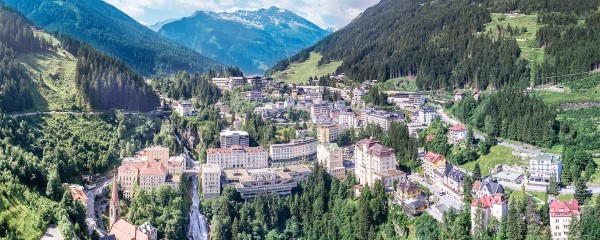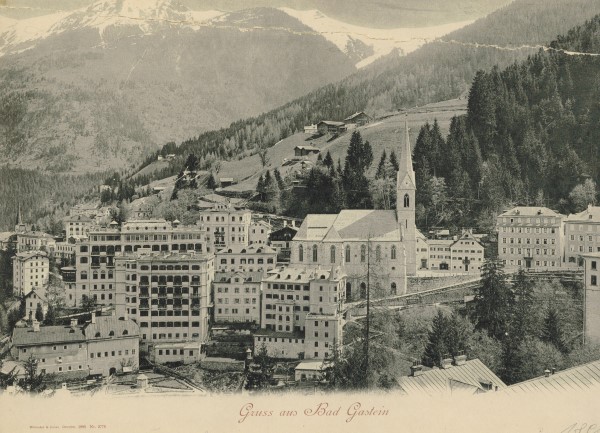- Year 1891, 07.
- Mahler visited Bernhard Pollini (1838-1897) who was taking a cure in Bad Gastein.
- Mahler met Natalie Bauer-Lechner (1858-1921) here with whom he made some long walks.
- 06-06-1911 Letter from Bruno Walter (1876-1962) in Bad Gastein.
- 1940 (occupation of the Netherlands): Willem Mengelberg (1871-1951) takes a cure in Bad Gastein. Later denied by Mengelberg.
Bad Gastein (formerly Badgastein) is a spa town in the district of St. Johann im Pongau, in the Austrian state of Salzburg. Picturesquely situated in a high valley of the Hohe Tauern mountain range, it is known for the Gastein Waterfall and a variety of Belle Époque hotel buildings.
Bad Gastein is located in the historic Pongau region, the municipal area of about 171 square kilometres (66 sq mi) is the largest in St. Johann im Pongau District. It stretches along the upper Gastein Valley following the course of the Gastein Ache creek, a right tributary of the Salzach river. The valley separates the Hohe Tauern Ankogel Group in the east from the Goldberg Group in the west.
The town centre is located at the Gastein Falls, about 1,000 metres (3,300 ft) above sea level. It is characterised by numerous historic multi-story hotel buildings erected on the steep slopes. The Gastein municipality comprises the cadastral communities of Badgastein, Böckstein, and Remsach. Its southern parts belong to the Hohe Tauern national park.
The name “Bad” means “spa”, reflecting the town’s history as a health resort. The local Heilstollen (literally ‘healing tunnel’) thermal spring water earned the town its early fame. Theophrastus Parcelsus (1493-1541) had studied the spring water to discover its secrets. Marie Curie (1867-1934) and Heinrich Mache (1876-1954) helped to discover that it contained radon and as a result radon therapy began in the town.
Radon inhalation therapy at the Gasteiner Heilstollen began as a result of further investigation into the anecdotal experiences of silver miners who noticed improvements in symptoms from various ailments including arthritis. Ankylosing spondylitis (also known as Bekhterev’s disease), in particular, has seen positive results from treatment at the Heilstollen. However, there is very little empirical evidence of any benefit to inhaling radon. For example, one of the few studies to test the efficacy of spa treatments for Ankylosing spondylitis found no statistically significant difference between a group that spent three weeks at Bad Gastein and a group that spent three weeks at a different spa without radon inhalation therapy.
The remote valley was settled by Bavarian peasants in the 9th century; field names in the highest-lying southern parts also denote a Carantanian (Slavic) colonization. Gastein is first mentioned as Gastuna in a 963 deed, when the area belonged to the German stem duchy of Bavaria. It was originally an alpine farming and gold mining area and the site of an ancient trade route crossing the main ridge of the Central Eastern Alps.
In 1297 Duke Otto III and his brother Stephen I, both highly indebted, sold it to the Prince-Archbishops of Salzburg. Already about 1230, the minnesinger Neidhart von Reuental had referred to the hot springs in his Middle High German poem Die Graserin in der Gastein; the spas were visited by the Habsburg emperor Frederick III as well as by the Renaissance physician Paracelsus.

In the 19th century the waters of Bad Gastein became a fashionable resort, visited by European monarchs as well as the rich and famous. Some notable guests of the past included Empress Elisabeth of Austria (Sisi) and the German Emperor Wilhelm I with his chancellor Otto von Bismarck as well as Subhas Chandra Bose, a leading Indian nationalist, Tsar Ferdinand I of Bulgaria, King Faisal I of Iraq, King Ibn Saud of Saudi Arabia and Iran’s last king Mohammad Reza Pahlavi, industrialists like Wilhelm von Opel and artists like Heinrich Mann, Robert Stolz and W. Somerset Maugham. On 14 August 1865 Bismarck had signed the Gastein Convention with Austria concerning the joint administration of the provinces of Schleswig and Holstein after the Second Schleswig War.
The composer Franz Schubert (1797-1828) composed his Piano Sonata in D Major in Bad Gastein, and was once believed to have sketched a Gmunden-Gastein Symphony (D. 849) during his stay in August and September 1825. Though no score appears to have survived for the latter, it is often identified with the Symphony No. 9 in C major (D. 944).
Mass tourism was pushed by the opening of the Tauern Railway station in 1905. From the 1960s on the resort lost some of its former notoriety and many former hotels sit empty. During the past few years, Bad Gastein renovated its Felsentherme and the Congress Center.

